|
|
PA-FE-TX and PA-FE-FX Fast Ethernet 100BASE-T Port Adapter Installation and Configuration
Product Numbers: PA-FE-TX(=) and PA-FE-FX(=)
This configuration note describes the installation and configuration of the 100BASE-TX and 100BASE-FX port adapters, which can be used in the Cisco 7200 series routers, and on the second-generation Versatile Interface Processor (VIP2) in all Cisco 7500 series routers, and Cisco 7000 series routers using the 7000 Series Route Switch Processor (RSP7000) and 7000 Series Chassis Interface (RSP7000CI). (Refer to the section "Software and Hardware Requirements" on page 3.)
For complete descriptions of interface subcommands and the configuration options available for interfaces, and which support FE-TX and FE-FX port adapter functionality, refer to the appropriate software configuration publication listed in the section "If You Need More Information."
This configuration note is organized into the following three parts.
The following sections include general reference information: "SELV Circuit Warning Translations," on page 44, and "Cisco Connection Online" on page 45
The Cisco Internetwork Operating System (Cisco IOS) software running the router contains extensive features and functionality. The effective use of many of many of these features is easier if you have more information at hand. For additional information on configuring the Cisco 7000 family routers and VIP2, or the Cisco 7200 series, the following documentation resources are available to you:
cs-rep@cisco.com
. You can also refer to the Cisco Information Packet that shipped with your router.
Port Adapter Installation Prerequisites
This section provides software requirements, a list of parts and tools you will need to perform the port adapter installation, and safety and ESD-prevention guidelines to help you avoid injury and damage to the equipment during installation. Also included is information on the systems in which port adapters can be installed and overview information on interface specifications.
The following sections discuss general information and information about port adapter installation requirements:
Software and Hardware Requirements
The FE-TX and FE-FE port adapters require that the host Cisco 7000 family router is running Cisco IOS Release 11.1(471), or later, and that the host Cisco 7200 series router is running Cisco IOS Release 11.1(472) or later.
You need the following tools and parts to install a port adapter. If you need additional equipment, contact a service representative for ordering information.
Following are safety guidelines that you should follow when working with any equipment that connects to electrical power or telephone wiring.
Electrical Equipment Guidelines
Follow these basic guidelines when working with any electrical equipment:
Use the following guidelines when working with any equipment that is connected to telephone wiring or to other network cabling:
Preventing Electrostatic Discharge Damage
Electrostatic discharge (ESD) damage, which can occur when electronic cards or components are improperly handled, results in complete or intermittent failures. Port adapters and processor modules comprise printed circuit boards that are fixed in metal carriers. Electromagnetic interference (EMI) shielding and connectors are integral components of the carrier. Although the metal carrier helps to protect the board from ESD, use a preventive antistatic strap during handling.
Following are guidelines for preventing ESD damage:
Each Fast Ethernet port on the FE-TX port adapter has an RJ-45 connector to attach to Category 5 unshielded twisted-pair (UTP) for 100BASE-TX, and a MII connector that permits connection through external transceivers to multimode fiber for 100BASE-FX, or to Category 3, 4, and 5 UTP or shielded twisted-pair (STP) for 100BASE-T4 physical media. Each Fast Ethernet port on the FE-FX port adapter has an SC-type fiber-optic connector for 100BASE-FX, and an MII connector that permits connection through external transceivers to multimode fiber for 100BASE-FX, or to Category 3, 4, and 5 UTP or shielded twisted-pair (STP) for 100BASE-T4 physical media.
The term Ethernet is commonly used for all carrier sense multiple access/collision detection (CSMA/CD), local-area networks (LANs) that generally conform to Ethernet specifications, including Fast Ethernet under IEEE 802.3u.
IEEE 802.3u is well suited to applications where a local communication medium must carry sporadic, occasionally heavy traffic at high peak data rates. Stations on a CSMA/CD LAN can access the network at any time. Before sending data, the station listens to the network to see if it is already in use. If it is, the station waits until the network is not in use, then transmits; this is half-duplex operation.
A collision occurs when two stations listen for network traffic, hear none, and transmit very close to simultaneously. When this happens, both transmissions are damaged, and the stations must retransmit. The stations detect the collision and use backoff algorithms to determine when they should retransmit. Both Ethernet and IEEE 802.3u are broadcast networks, which means that all stations see all transmissions. Each station must examine received frames to determine whether it is the intended destination and, if it is, pass the frame to a higher protocol layer for processing.
IEEE 802.3u specifies the following different physical layers for 100BASE-T:
Each physical layer protocol has a name that summarizes it characteristics in the format speed/signaling method/segment length where speed is the LAN speed in megabits per second (Mbps), signaling method is the signaling method used (either baseband or broadband), and segment length is typically the maximum length between stations in hundreds of meters. Therefore, 100BASE-T specifies a 100-Mbps, baseband LAN with maximum network segments of 100 meters (or 400 meters for 100BASE-FX).
IEEE 802.3u 100BASE-T Specifications
Table 1 lists the cabling specifications for 100-Mbps Fast Ethernet transmission over UTP, STP, and fiber-optic cables. Table 2 summarizes IEEE 802.3u 100BASE-T physical characteristics for 100BASE-TX and 100BASE-FX.
Table 1 : Specifications and Connection Limits for 100-Mbps Transmission
Table 2 : IEEE 802.3u Physical Characteristics
What Are the FE-TX and FE-FX Port Adapters?
The FE-TX or FE-FX port adapters provide a 100-Mbps, 100BASE-T Fast Ethernet interface. Both full-duplex and half-duplex operation are supported for the FE-TX and FE-FX port adapters. Refer to the section "Fast Ethernet Overview" for additional information. The FE-TX and FE-FX port adapters are shown in Figure 1 and Figure 2.
Figure 1 : FE-TX Port Adapter, Faceplate View
Figure 2 : FE-FX Port Adapter, Faceplate View
The following sections discuss the FE-TX and FE-FX port adapters:
Port Adapter Locations on the VIP2 and in the Cisco 7200 Series Router
Figure 3 shows VIP2 with installed port adapters. With the VIP2 oriented as shown in Figure 3, the left port adapter is in port adapter slot 0, and the right port adapter is in port adapter slot 1. Port adapters have handles that allow for easy installation and removal; however, they are occasionally not shown in this publication to highlight port adapter faceplate detail. In the Cisco 7000, Cisco 7507, and Cisco 7513 chassis the VIP2 is installed vertically. In the Cisco 7010 and Cisco 7505 chassis the VIP2 is installed horizontally.
Figure 3 : VIP2 with Two Port Adapters Installed (Horizontal Orientation Shown)
Figure 4 shows a Cisco 7206 with port adapters installed. In the Cisco 7206, port adapter slot 1 is in the lower left position and port adapter slot 6 is in the upper right position.
Figure 4 : Cisco 7206 with Port Adapters Installed
The FE-TX and FE-FX port adapters contain the enabled LED, standard on all port adapters, and a bank of three status LEDs for the ports. After system initialization, the enabled LED goes on to indicate that the FE-TX port adapter has been enabled for operation. (The LEDs are shown in Figure 5.) The following conditions must be met before the enabled LED goes on:
If any of these conditions is not met, or if the initialization fails for other reasons, the enabled LED does not go on.
Following are the three status LEDs and an explanation of what each indicates:
Either the MII LED or the RJ-45 (or FIBER) LED should be on at any one time; never both.
Figure 5 : LEDs on the FE Port Adapter (Partial Faceplate View of FE-TX)
FE Port Adapter Receptacles, Cables, and Pinouts
The two interface receptacles on the FE port adapter are a single MII, 40-pin, D-shell type, and a single RJ-45 (or SC-type for FE-FX optical-fiber connections). You can use either one or the other. Only one receptacle can be used at one time. Each connection supports IEEE 802.3u interfaces compliant with the 100BASE-X and 100BASE-T standards. The RJ-45 connection does not require an external transceiver. The MII connection requires an external physical sublayer (PHY) and an external transceiver.
Figure 6 shows the RJ-45 cable connectors. Cisco Systems does not supply Category 5 UTP RJ-45 cables; these cables are available commercially. Table 3 lists the pinouts and signals for the FE-TX RJ-45 connectors.
Figure 6 : FE-TX RJ-45 Connections, Plug and Receptacle
Table 3 : FE-TX RJ-45 Connector Pinout
Depending on your RJ-45 interface cabling requirements, use the pinouts in Figure 7 and Figure 8.
Figure 7 : Straight-Through Cable Pinout, FE-TX RJ-45 Connection to a Hub or Repeater
Figure 8 : Crossover Cable Pinout, FE-TX RJ-45 Connections Between Hubs and Repeaters
Figure 9 shows the duplex SC connector (one required for both transmit and receive), and Figure 10 shows the simplex SC connector (two required, one for each transmit and receive) used for FE-FX optical-fiber connections. These multimode optical-fiber cables are commercially available, and are not available from Cisco Systems.
Figure 9 : FE-FX Duplex SC Connector
Figure 10 : FE-FX Simplex SC Connector
Depending on the type of media you use between the MII connection on the port adapter and your switch or hub, the network side of your 100BASE-T transceiver should be appropriately equipped with ST-type connectors (for optical fiber), BNC connectors, and so forth. Figure 11 shows the pin orientation of the female MII connector on the port adapter. The port adapters are field-replacable units (FRUs).
The MII receptacle uses 2-56 screw-type locks, called jackscrews (shown in Figure 11), to secure the cable or transceiver to the MII port. MII cables and transceivers have knurled thumbscrews (screws you can tighten with your fingers) that you fasten to the jackscrews on the FE-TX port adapter's MII connector. Use the jackscrews to provide strain relief for your MII cable. (The RJ-45 modular plug has strain relief functionality incorporated into the design of its standard plastic connector.) Figure 11 shows the MII female connector.
Figure 11 : FE-TX or FE-FX MII Connection, Receptacle
Table 4 lists the MII connector pinout and signals. MII cables are available commercially, and are not available from Cisco Systems. Table 4 refers to MII cables used between the MII connector on the FE-TX port adapter and an appropriate transceiver. The connection between this transceiver and your network can be Category 3, 4, or 5, 150-ohm UTP or STP, or multimode optical fiber.
Table 4 : MII Connector Pinout
VIP2 and the FE-TX and FE-FX Port Adapters
The FE-TX and FE-FX port adapters are used on the VIP2, and can be installed in either port adapter slot 0 or port adapter slot 1. Figure 12 shows a FE-TX port adapter installed in port adapter slot 0 on a VIP2. Figure 13 shows a FE-FX port adapter installed in port adapter slot 0 on a VIP2.
Figure 12 : VIP2 with an FE-TX Port Adapter Port Adapter Slot 0
Figure 13 : VIP2 with an FE-FX Port Adapter Port Adapter Slot 0
The following sections include information specific to the FE-TX and FE-FX port adapters and their use on the second-generation Versatile Interface Processor (VIP2) in Cisco 7000 family routers:
Installing or Replacing a Port Adapter on a VIP2
Depending on the circumstances you might need to install a new port adapter on a VIP2 motherboard or replace a failed port adapter in the field. In either case, you need a number 1 Phillips screwdriver, an antistatic mat onto which you can place the removed interface processor, and an antistatic container into which you can place a failed port adapter for shipment back to the factory.
When only one port adapter is installed on a VIP2, a blank port adapter must fill the empty slot to allow the VIP2 and router chassis to conform to electromagnetic interference (EMI) emissions requirements, and so that air flows through the chassis properly. If you plan to install a new port adapter, you must first remove the blank port adapter.
Following is the standard procedure for removing and replacing any type of port adapter on the VIP2:
Figure 14 : Location of Port Adapter Screw, Partial Port Adapter View
Figure 15 : Pulling a Port Adapter Out of a Slot, Partial Port Adapter View
Figure 16 : Removing a Port Adapter
Figure 17 : Aligning the Carrier Edge with Upper and Lower Slot Edges, Partial View
This completes the procedure for installing a new port adapter or replacing a port adapter on a VIP2.
Attaching FE-TX and FE-FX Port Adapter Interface Cables
On a single FE port adapter, you can use either the RJ-45 (or SC for FE-FX) connection or the MII connection. If you have two FE port adapters on your VIP2, you can use the RJ-45 (or SC for FE-FX) connection on one port adapter and the MII connection on the other port adapter.
Connect RJ-45, SC (FE-FX), or MII cables as follows:
Figure 18 : Connecting FE-TX MII or RJ-45 Cables (Horizontal Orientation---Shown without Handles)
Figure 19 : Connecting FE-FX MII or SC Cables (Horizontal Orientation---Shown without Handles)
Figure 20 : Attaching the Ferrite Bead around the RJ-45 Cable
This completes the FE port adapter cable installation.
Configuring the Fast Ethernet Interface
If you installed a new FE interface or if you want to change the configuration of an existing interface, you must enter Configuration mode, using the configuration command. If you replaced an interface that was previously configured, the system will recognize the new interface and bring it up in its existing configuration.
After you verify that the new FE interface is installed correctly (the enabled LED goes on), use the privileged-level configure command to configure the new interfaces. Be prepared with the information you will need, such as the following:
For a summary of the configuration options available and instructions for configuring the Fast Ethernet interfaces on the VIP2, refer to the appropriate configuration publications listed in the section "If You Need More Information" on page 2.
The configure command requires privileged-level access to the EXEC command interpreter, which usually requires a password. Contact your system administrator if necessary to obtain EXEC-level access.
Selecting Chassis Slot, Port Adapter, and Fast Ethernet Interface Port Numbers
The following section describes how to identify chassis slot, port adapter, and Fast Ethernet interface port numbers.
In the router, physical port addresses specify the actual physical location of each interface port on the router interface processor end. (See the example of an FE-TX port adapter shown in Figure 21.) This address is composed of a three-part number in the format chassis slot number/port adapter number/interface port number.
Interface ports on the VIP2 maintain the same address regardless of whether other interface processors are installed or removed. However, when you move a VIP2 to a different slot, the first number in the address changes to reflect the new slot number.
Figure 21 shows some of the slot port adapter and interface ports of a sample Cisco 7505 system. The first port adapter slot number is 0 and the second port adapter slot number is 1. The individual FE interface numbers are always 0. For example, on the FE-quipped VIP2 in slot 3 (shown in Figure 21), the address of the FE interface is 3/0/0 (chassis slot 3, port adapter slot 0, and interface port 0). If a second FE port adapter was installed in port adapter slot 1 on this VIP2, its address would be 3/1/0.
Figure 21 : Fast Ethernet Interface Port Number Example (Cisco 7505 Shown)
You can identify interface ports by physically checking the slot/port adapter/interface port location on the back of the router or by using software commands to display information about a specific interface or all interfaces in the router.
Configuring Interfaces---Descriptions and Examples
The following steps describe a basic configuration. Press the Return key after each step unless otherwise noted. At any time you can exit the privileged level and return to the user level by entering disable at the prompt as follows:
Following is a basic configuration procedure:
Following are descriptions and examples of the commands for configuring the FE interface 3/0/0 (slot 3, port adapter 0, Fast Ethernet interface port 0). Descriptions are limited to fields that are relevant for establishing and verifying the configuration. After configuring the new FE interface, use show commands to display the status of the new interface or all interfaces, or to verify changes you have made.
Depending on the requirements for your system configuration and the protocols you plan to route on the interface, you might also need to enter other configuration subcommands. For complete descriptions of configuration subcommands and the configuration options available for Fast Ethernet interfaces, refer to the publications listed in the section "If You Need More Information" on page 2.
FE half-duplex operation is the default. To change to full-duplex operation, use the following series of commands:
Using the show interfaces fastethernet command, you can see that the 3/0/0 Fast Ethernet interface is now configured for full-duplex operation, as follows:
To return the interface to half-duplex operation, use the no full-duplex configuration command, as follows:
Using the show interfaces fastethernet command, you can see that the 3/0/0 Fast Ethernet interface is now configured for half-duplex operation, as follows:
The RJ-45 connection is the default for FE-TX (or SC for FE-FX). To change to an MII connection and then verify it, use the following series of commands, including the media-type configuration command:
Use the media-type 100 configuration command to return the interface to its default state for RJ-45 or SC (fiber-optic) connections.
After configuring the new interface, use the show commands to display the status of the new interface or all interfaces and the ping command to check connectivity.
Using show Commands to Verify the VIP2 Status
The following steps use show commands to verify that the new interfaces are configured and operating correctly.
If the interface is down and you configured it as up, or if the displays indicate that the hardware is not functioning properly, ensure that the network interface is properly connected and terminated. If you still have problems bringing the interface up, contact a service representative for assistance.
Using show Commands to Display Interface Information To display information about a specific interface, use the show interfaces command with the interface type and port address in the format show interfaces [type slot/port adapter/port].
Following is an example of how the show interfaces command displays status information (including the physical slot and port address) for the interface you specify. In this example, most of the status information for each interface is omitted, and a Fast Ethernet interface in slot 3 is used.
The Fast Ethernet interface port adapter is numbered as port adapter 0. The MII and RJ-45 (or SC) ports on a port adapter each have the same port number because only one of them can be used at one time. The single Fast Ethernet port on the FE port adapter is interface 0.
With the show interfaces type slot/port adapter/port command, use arguments such as the interface type (fastethernet, and so forth) and the port number (slot/port) to display information about a specific interface only. The following example of the show interfaces fastethernet command shows information specific to the Fast Ethernet interface on the first FE port adapter in slot 3:
The show version (or show hardware) command displays the configuration of the system hardware (the number of each interface processor type installed), the software version, the names and sources of configuration files, and the boot images. Following is an example of the show version command used with a Cisco 7500 series system:
To determine which type of port adapter is installed on a VIP2 in your system, use the show diag slot command. Specific port adapter information is displayed, as shown in the following example of an FE-FX port adapter in chassis slot 1:
For complete VIP2 command descriptions and examples, refer to the publications listed in the section "If You Need More Information" on page 2.
Using the ping Command The packet internet groper (ping) command allows you to verify that an interface port is functioning properly and to check the path between a specific port and connected devices at various locations on the network. This section provides brief descriptions of the ping command. After you verify that the system and VIP2 have booted successfully and are operational, you can use this command to verify the status of interface ports. Refer to the publications listed in the section "If You Need More Information" on page 2, for detailed command descriptions and examples.
The ping command sends an echo request out to a remote device at an IP address that you specify. After sending a series of signals, the command waits a specified time for the remote device to echo the signals. Each returned signal is displayed as an exclamation point (!) on the console terminal; each signal that is not returned before the specified time-out is displayed as a period (.). A series of exclamation points (!!!!!) indicates a good connection; a series of periods (.....) or the messages [timed out] or [failed] indicate that the connection failed.
Following is an example of a successful ping command to a remote server with the address 1.1.1.10:
For complete descriptions of interface subcommands and the configuration options available for VIP2-related interfaces, and which support VIP2 functionality, refer to the publications listed in the section "If You Need More Information" on page 2.
Cisco 7200 Series and the FE-TX and FE-FX Port Adapters
The FE-TX and FE-FX port adapters are used in the Cisco 7200 series routers and can be installed in any of the available port adapter slots. Figure 22 shows a Cisco 7206 with an FE-TX port adapter installed in port adapter slot 4.
Figure 22 : Cisco 7206 with an FE-TX Port Adapter in Port Adapter Slot 4
Figure 23 shows a Cisco 7206 with an FE-TX port adapter installed in slot 4.
Figure 23 : Cisco 7206 with an FE-FX Port Adapter in Port Adapter Slot 4
The following sections include information specific to the FE-TX and FE-FX port adapters and their use in the Cisco 7200 series routers:
Installing or Replacing a Port Adapter in Cisco 7200 Series Routers
Depending on your circumstances, you might need to install a new port adapter in a Cisco 7200 series router or replace a failed port adapter in the field. In either, case no tools are necessary; all port adapters available for the Cisco 7200 series connect directly to the router midplane and are locked into position by a port adapter lever. When removing and replacing a port adapter, you will need an antistatic mat onto which you can place a removed port adapter and an antistatic container into which you can place a failed port adapter for shipment back to the factory.
When a port adapter slot is not in use, a blank port adapter must fill the empty slot to allow the router to conform to EMI emissions requirements and to allow proper air flow across the port adapters. If you plan to install a new port adapter in a slot that is not in use, you must first remove a blank port adapter.
Following is the procedure for removing a port adapter from a Cisco 7200 series router:
Figure 24 : Placing the Port Adapter Lever in the Unlocked Position (Cisco 7206 shown)
Figure 25 : Handling a Port Adapter
This completes the procedure for removing a port adapter from a Cisco 7200 series router.
Following is the procedure for installing a new port adapter in a Cisco 7200 series router:
Figure 26 : Aligning the Port Adapter Metal Carrier Between the Slot Guides (Cisco 7206 shown)
Figure 27 : Placing the Port Adapter Lever in the Locked Position (Cisco 7206 shown)
This completes the procedure for installing a new port adapter in a Cisco 7200 series router.
Attaching FE-TX and FE-FX Port Adapter Interface Cables
On a single FE port adapter, you can use either the RJ-45 (or SC for FE-FX) connection or the MII connection. If you have two FE port adapters, you can use the RJ-45 (or SC for FE-FX) connection on one port adapter and the MII connection on the other port adapter.
Connect RJ-45, SC (FE-FX), or MII cables as follows:
Figure 28 : Connecting FE-TX MII or RJ-45 Cables
Figure 29 : Connecting FE-FX MII or SC Cables
Figure 30 : Attaching the Ferrite Bead around the RJ-45 Cable
This completes the FE port adapter cable installation.
Configuring the Fast Ethernet Interface
If you installed a new FE port adapter or if you want to change the configuration of an existing interface, you must enter Configuration mode using the configuration command. If you replaced an interface that was previously configured, the system will recognize the new interface and bring it up in its existing configuration.
After you verify that the new FE interface is installed correctly (the enabled LED goes on), use the privileged-level configure command to configure the new interfaces. Be prepared with the information you will need, such as the following:
For a summary of the configuration options available and instructions for configuring the Fast Ethernet interfaces on a Cisco 7200 series router, refer to the appropriate configuration publications listed in the section "If You Need More Information" on page 2.
The configure command requires privileged-level access to the EXEC command interpreter, which usually requires a password. Contact your system administrator if necessary to obtain EXEC-level access.
Selecting Port Adapter Slot and Fast Ethernet Interface Port Numbers
The following section describes how to identify port adapter slot and Fast Ethernet interface port numbers.
Physical port addresses specify the actual physical location of each interface port on the router. (See the example of an FE-TX port adapter shown in Figure 31.) This address is composed of a two-part number in the format port adapter slot number/interface port number, as follows:
Interface ports maintain the same address regardless of whether other port adapters are installed or removed from the slot. However, when you move a port adapter to a different slot, the first number in the address changes to reflect the new chassis slot number.
Figure 21 shows some of the port adapter slots and interface ports of a Cisco 7206. The port adapter slot numbers start with 1 and continue through 6 (slot 0 is always reserved for the Fast Ethernet port on the I/O controller---if present).
For example, on the FE port adapter in slot 2 the address of the FE interface is 2/0 (port adapter slot 2, and interface port 0). (Refer to Figure 31)
Figure 31 : Fast Ethernet Interface Port Number Example
You can identify interface ports by physically checking the slot/interface port location on the front of the router or by using show commands to display information about a specific interface or all interfaces in the router.
The following steps describe a basic interface configuration. Press the Return key after each step unless otherwise noted. At any time you can exit the privileged level and return to the user level by entering disable at the prompt as follows:
Following is an example of a basic configuration procedure:
Following are descriptions and examples of the commands for configuring the FE interface 4/0
Depending on the requirements for your system configuration and the protocols you plan to route on the interface, you might also need to enter other configuration subcommands. For complete descriptions of configuration subcommands and the configuration options available for Fast Ethernet interfaces, refer to the publications listed in the section "If You Need More Information" on page 2.
FE half-duplex operation is the default. To change to full-duplex operation, use the following series of commands:
Using the show interfaces fastethernet command, you can see that the 4/0 Fast Ethernet interface is now configured for full-duplex operation, as follows:
To return the interface to half-duplex operation, use the no full-duplex configuration command, as follows:
Using the show interfaces fastethernet command, you can see that the 4/0 Fast Ethernet interface is now configured for half-duplex operation, as follows:
The RJ-45 connection is the default for FE-TX (or SC for FE-FX). To change to an MII connection and then verify it, use the following series of commands, including the media-type configuration command:
Use the media-type 100 configuration command to return the interface to its default state for RJ-45 or SC (fiber-optic) connections.
After configuring the new interface, use the show commands to display the status of the new interface or all interfaces and use the ping command to check connectivity.
Using show Commands to Verify the New Interface Status
The following steps use show commands to verify that the new interfaces are configured and operating correctly.
If the interface is down and you configured it as up, or if the displays indicate that the hardware is not functioning properly, ensure that the network interface is properly connected and terminated. If you still have problems bringing the interface up, contact a service representative for assistance.
Using show Commands to Display Interface Information
To display information about a specific interface, use the show interfaces command with the interface type and port address in the format show interfaces [type slot/port].
Following is an example of how the show interfaces [type slot/port] command displays status information (including the physical slot and port address) for the interface you specify. In this example, most of the status information for each interface is omitted, and a Fast Ethernet interface in slot 4 is used.
The Fast Ethernet interface port adapter is numbered as port adapter 0. The MII and RJ-45 (or SC) ports on a port adapter each have the same port number because only one of them can be used at one time. The single Fast Ethernet port on the FE port adapter is interface 0.
With the show interfaces type slot/port command, use arguments such as the interface type (fastethernet, and so forth) and the port number (slot/port) to display information about a specific interface only. The following example of the show interfaces fastethernet command shows information specific to the Fast Ethernet interface on the first FE port adapter in slot 4:
The show version (or show hardware) command displays the configuration of the system hardware (the number of each port adapter type installed), the software version, the names and sources of configuration files, and the boot images. Following is an example of the show version command:
To determine which type of port adapter is installed in your system, use the show diag slot command. Specific port adapter information is displayed, as shown in the following example of an FE-FX port adapter in chassis slot 4:
For command descriptions and examples for the Cisco 7200 series routers, refer to the publications listed in the section "If You Need More Information" on page 2.
Using the ping Command
The packet internet groper (ping) command allows you to verify that an interface port is functioning properly and to check the path between a specific port and connected devices at various locations on the network. This section provides brief descriptions of the ping command. After you verify that the system has booted successfully and is operational, you can use this command to verify the status of interface ports. Refer to the publications listed in the section "If You Need More Information" on page 2 for detailed command descriptions and examples.
The ping command sends an echo request out to a remote device at an IP address that you specify. After sending a series of signals, the command waits a specified time for the remote device to echo the signals. Each returned signal is displayed as an exclamation point (!) on the console terminal; each signal that is not returned before the specified time-out is displayed as a period (.). A series of exclamation points (!!!!!) indicates a good connection; a series of periods (.....) or the messages [timed out] or [failed] indicate that the connection failed.
Following is an example of a successful ping command to a remote server with the address 1.1.1.10:
For complete descriptions of interface subcommands and the configuration options available for Cisco 7200 series-related interfaces, refer to the publications listed in the section "If You Need More Information" on page 2.
SELV Circuit Warning Translations
Warning The ports labeled "Ethernet," "10BaseT," "Token Ring," "Console," and "AUX" are safety extra-low voltage (SELV) circuits. SELV circuits should only be connected to other SELV circuits. Because the BRI circuits are treated like telephone-network voltage, avoid connecting the SELV circuit to the telephone network voltage (TNV) circuits.
Waarschuwing De poorten die "Ethernet", "10BaseT", "Token Ring", "Console" en "AUX" zijn gelabeld, zijn veiligheidscircuits met extra lage spanning (genaamd SELV = Safety Extra-Low Voltage). SELV-circuits mogen alleen met andere SELV-circuits verbonden worden. Omdat de BRI-circuits op dezelfde manier als telefoonnetwerkspanning behandeld worden, mag u het SELV-circuit niet verbinden met de telefoonnetwerkspanning (TNV) circuits.
Varoitus Portit, joissa on nimet "Ethernet", "10BaseT", "Token Ring", "Console" ja "AUX", ovat erityisen pienen jännityksen omaavia turvallisuuspiirejä (SELV-piirejä). Tällaiset SELV-piirit tulee yhdistää ainoastaan muihin SELV-piireihin. Koska perusluokan liitäntöjen (Basic Rate Interface- eli BRI-liitännät) jännite vastaa puhelinverkoston jännitettä, vältä SELV-piirin yhdistämistä puhelinverkoston jännitepiireihin (TNV-piireihin).
Attention Les ports étiquetés « Ethernet », « 10BaseT », « Token Ring », « Console » et « AUX » sont des circuits de sécurité basse tension (Safety Extra-Low Voltage ou SELV). Les circuits SELV ne doivent être interconnectés qu'avec d'autres circuits SELV. Comme les circuits BRI sont considérés comme des sources de tension de réseau téléphonique, éviter de connecter un circuit SELV à un circuit de tension de réseau téléphonique (telephone network voltage ou TNV).
Warnung Die mit "Ethernet", "10BaseT", "Token Ring", "Console" und "AUX" beschrifteten Buchsen sind Sicherheitskreise mit Sicherheitskleinspannung (Safety Extra-Low Voltage, SELV). SELV-Kreise sollten ausschließlich an andere SELV-Kreise angeschlossen werden. Da die BRI-Kreise wie Telefonnetzspannungen behandelt werden, ist der SELV-Kreis nicht an Telefonnetzspannungskreise (TNV) anzuschließen.
Avvertenza Le porte contrassegnate da "Ethernet", "10BaseT", "TokenRing", "Console" e "AUX" sono circuiti di sicurezza con tensione molto bassa (SELV). I circuiti SELV devono essere collegati solo ad altri circuiti SELV. Dato che i circuiti BRI vengono trattati come tensioni di rete telefonica, evitare di collegare il circuito SELV ai circuiti in cui è presente le tensione di rete telefonica (TNV).
Advarsel Utgangene merket "Ethernet", "10BaseT", "Token Ring", "Console" og "AUX" er lavspentkretser (SELV) for ekstra sikkerhet. SELV-kretser skal kun kobles til andre SELV-kretser. Fordi BRI-kretsene håndteres som telenettspenning, unngå å koble SELV-kretsen til kretser for telenettspenning (TNV).
Aviso As portas "Ethernet", "10BaseT", "Token Ring", "Console", and "AUX" são circuitos de segurança de baixa tensão (SELV). Estes circuitos deverão ser apenas ligados a outros circuitos SELV. Devido ao facto de os circuitos BRI (Interface de Ritmo Básico) serem tratados como sendo de tensão equivalente à da rede telefónica, evite ligar o circuito SELV aos circuitos TNV (tensão de rede telefónica).
¡Advertencia! Los puertos "Ethernet", "10BaseT", "Token Ring", "Console" y "AUX" son circuitos de muy baja señal que garantizan ausencia de peligro (Safety Extra-Low Voltage = SELV). Estos circuitos SELV deben ser conectados exclusivamente con otros también de tipo SELV. Puesto que los circuitos tipo BRI se comportan como aquéllos con voltajes de red telefónica, debe evitarse conectar circuitos SELV con circuitos de voltaje de red telefónica (TNV).
Varning! De portar som är märkta "Ethernet", "10BaseT", "Token Ring", "Console" och "AUX" är SELV-kretsar, d.v.s. skyddskretsar med extra låg spänning (SELV: Safety Extra-Low Voltage = skyddsklenspänning). SELV-kretsar får endast anslutas till andra SELV-kretsar. Eftersom BRI-kretsar behandlas liksom telefonnätsspänning bör SELV-kretsen inte anslutas till telefonnätsspänningskretsar (TNV-kretsar).
Cisco Connection Online (CCO), formerly Cisco Information Online (CIO), is Cisco Systems' primary, real-time support channel. Maintenance customers and partners can self-register on CCO to obtain additional content and services.
Available 24 hours a day, 7 days a week, CCO provides a wealth of standard and value-added services to Cisco's customers and business partners. CCO services include product information, software updates, release notes, technical tips, the Bug Navigator, configuration notes, brochures, descriptions of service offerings, and download access to public and authorized files.
CCO serves a wide variety of users through two interfaces that are updated and enhanced simultaneously---a character-based version and a multimedia version that resides on the World Wide Web (WWW). The character-based CCO supports Zmodem, Kermit, Xmodem, FTP, Internet e-mail, and fax download options, and is excellent for quick access to information over lower bandwidths. The WWW version of CCO provides richly formatted documents with photographs, figures, graphics, and video, as well as hyperlinks to related information.
You can access CCO in the following ways:
For a copy of CCO's Frequently Asked Questions (FAQ), contact
Copyright 1988-1996 © Cisco Systems Inc.
![]()
![]()
Parameter
RJ-45
MII
SC-Type
Cable specification
Category 51 UTP2, 22 to 24 AWG3
Category 3, 4, or 5, 150-ohm UTP or STP, or multimode optical fiber
62.5/125 multimode optical fiber
Maximum cable length
--
0.5 m (1.64 ft.) (MII-to-MII cable4)
--
Maximum segment length
100 m (328 ft.) for 100BASE-TX
1 m (3.28 ft.)5 or 400 m (1,312 ft.) for 100BASE-FX
100 m (328 ft.)
Maximum network length
200 m (656 ft)5. (with 1 repeater)
--
200 m (656 ft)5. (with 1 repeater)
1 EIA/TIA-568 or EIA-TIA-568 TSB-36 compliant.
2 Cisco Systems does not supply Category 5 UTP RJ-45 or 150-ohm STP MII cables. Both are available commercially.
3 AWG = American Wire Gauge. This gauge is specified by the EIA/TIA-568 standard.
4 This is the cable between the MII port on the FE port adapter and the appropriate transceiver.
5 This length is specifically between any two stations on a repeated segment.
Parameter
100BASE-FX
100BASE-TX
Data rate (Mbps)
100
100
Signaling method
Baseband
Baseband
Maximum segment length (meters)
100 m between repeaters
100 m between DTE1 and repeaters
Media
SC-type: dual simplex or single duplex for Rx and Tx
RJ-45MII
Topology
Star/Hub
Star/Hub
1 DTE = data terminal equipment.


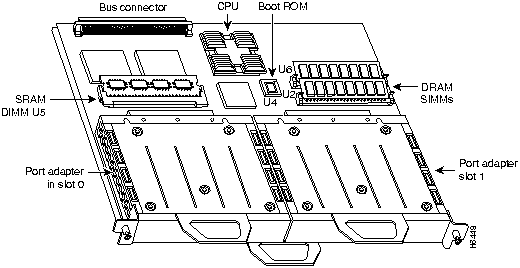
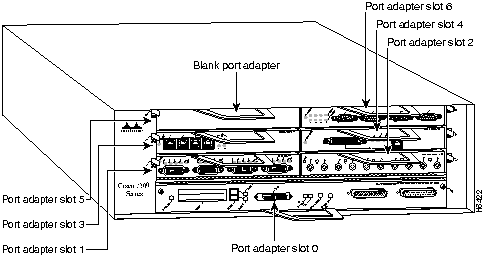


![]()
Pin
Description
1
Receive Data + (RxD+)
2
RxD--
3
Transmit Data + (TxD+)
6
TxD--
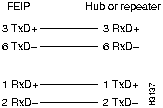
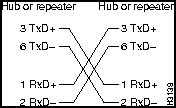



Pin1
In
Out
In/Out
Description
14--17
--
Yes
--
Transmit Data (TxD)
12
Yes
--
--
Transmit Clock (Tx_CLK)2
11
--
Yes
--
Transmit Error (Tx_ER)
13
--
Yes
--
Transmit Enable (Tx_EN)
3
--
Yes
--
MII Data Clock (MDC)
4--7
Yes
--
--
Receive Data (RxD)
9
Yes
--
--
Receive Clock (Rx_CLK)
10
Yes
--
--
Receive Error (Rx_ER)
8
Yes
--
--
Receive Data Valid (Rx_DV)
18
Yes
--
--
Collision (COL)
19
Yes
--
--
Carrier Sense (CRS)
2
--
--
Yes
MII Data Input/Output (MDIO)
22--39
--
--
--
Common (ground)
1, 20, 21, 40
--
--
--
+5.0 volts (V)
1 Any pins not indicated are not used.
2 Tx_CLK and Rx_CLK are generated by the external transceiver.
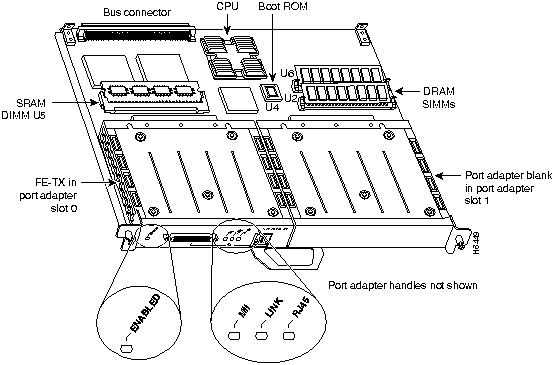

![]()
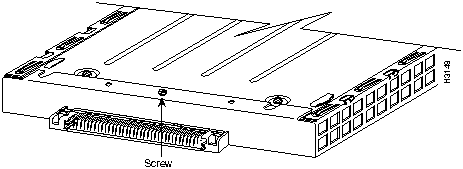
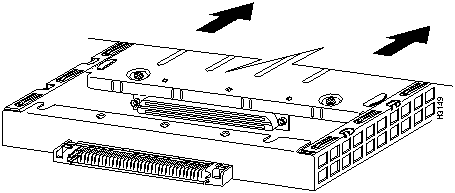
![]()
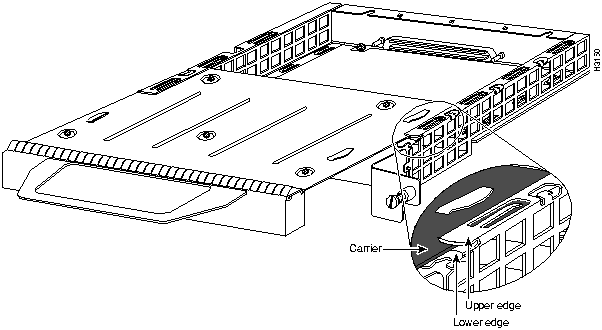
![]()
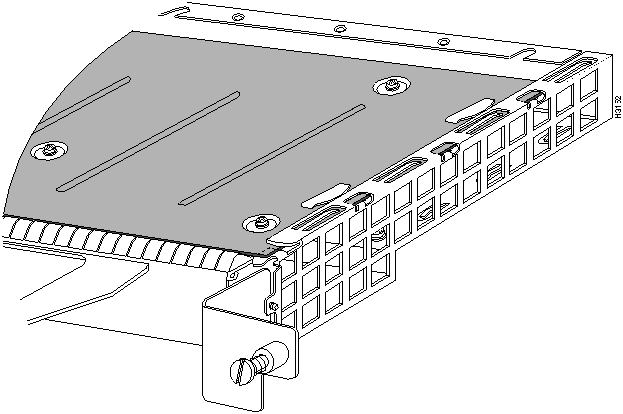
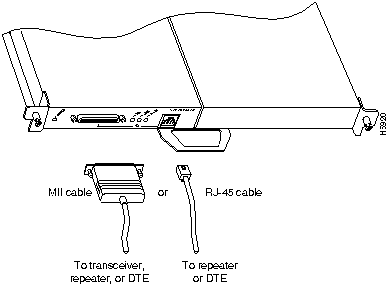
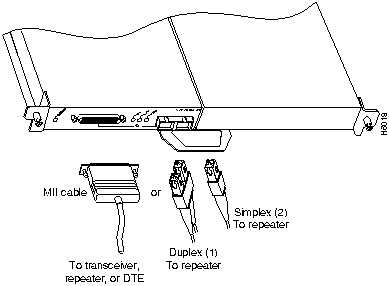
![]()

![]()

Router# disable
Router>
Router#
configure terminal
Enter configuration commands, one per line. End with CNTL/Z.
Router(config)#
Router(config)#
interface fe 1/0/0
Router(config-int)#
ip address 1.1.1.10 255.255.255.0
Router(config-int)#
no shutdown
Router#
copy running-config startup-config
[OK]
Router#
Router# configure terminal
Enter configuration commands, one per line. End with CNTL/Z.
Router(config)#
Router(config)# interface fastethernet 3/0/0
Router(config-if)# full-duplex
Ctrl-z
Router# sh int fa 3/0/0
FastEthernet 3/0/0 is administratively up, line protocol is up
(display text omitted)
Encapsulation ARPA, loopback not set, keepalive not set, fdx, 100BaseTX
Router# config t
Enter configuration commands, one per line. End with CNTL/Z.
Router(config)# int fa 3/0/0
Router(config-if)# no full-duplex
Ctrl-z
Router#
Router# sh int fa 3/0/0
FastEthernet3/0/0 is administratively up, line protocol is up
(display text omitted)
Encapsulation ARPA, loopback not set, keepalive not set, hdx, 100BaseTX
(display text omitted)
Router# config t
Enter configuration commands, one per line. End with CNTL/Z.
Router(config)# int fa 3/0/0
Router(config-if)# media-type mii
Ctrl-z
Router# sh int fa 3/0/0
FastEthernet3/0/0 is administratively up, line protocol is up
(display text omitted)
Encapsulation ARPA, loopback not set, keepalive not set, hdx, MII
(display text omitted)
Router# sh int fa 3/0/0
FastEthernet3/0/0 is administratively down, line protocol is down
Hardware is cyBus FastEthernet Interface, address is 0000.0ca5.2380 (bia 0000)
MTU 1500 bytes, BW 100000 Kbit, DLY 100 usec, rely 255/255, load 1/255
Encapsulation ARPA, loopback not set, keepalive set (10 sec), hdx, 100BaseTX
(display text omitted)
Router# show interfaces fastethernet 3/0/0
FastEthernet3/0/0 is administratively down, line protocol is down
Hardware is cyBus FastEthernet Interface, address is 0000.0ca5.2380 (bia 0000)
MTU 1500 bytes, BW 100000 Kbit, DLY 100 usec, rely 255/255, load 1/255
Encapsulation ARPA, loopback not set, keepalive set (10 sec), hdx, 100BaseTX
ARP type: ARPA, ARP Timeout 4:00:00
Last input 3:08:43, output 3:08:42, output hang never
Last clearing of "show interface" counters 2:58:36
Output queue 0/40, 0 drops; input queue 0/75, 0 drops
5 minute input rate 0 bits/sec, 0 packets/sec
5 minute output rate 0 bits/sec, 0 packets/sec
0 packets input, 0 bytes, 0 no buffer
Received 0 broadcasts, 0 runts, 0 giants
0 input errors, 0 CRC, 0 frame, 0 overrun, 0 ignored, 0 abort
0 watchdog, 0 multicast
0 input packets with dribble condition detected
0 packets output, 0 bytes, 0 underruns
0 output errors, 0 collisions, 0 interface resets, 0 restarts
0 babbles, 0 late collision, 0 deferred
0 lost carrier, 0 no carrier
0 output buffer failures, 0 output buffers swapped out
Router# show version
Cisco Internetwork Operating System Software
IOS (tm) GS Software (RSP-A), Version 11.1(471) [mpo 105]
Copyright (c) 1986-1995 by cisco Systems, Inc.
Compiled Fri 06-Oct-95 12:22 by mpo
Image text-base: 0x600088A0, data-base: 0x605A4000
ROM: System Bootstrap, Version 5.3(16645) [biff 571], RELEASED SOFTWARE
ROM: GS Bootstrap Software (RSP-BOOT-M), Version 11.0(1.2), MAINTENANCE
honda uptime is 4 hours, 22 minutes
System restarted by reload
System image file is "slot0:rsp-a111-1", booted via slot0
cisco RSP2 (R4600) processor with 32768K bytes of memory.
R4600 processor, Implementation 32, Revision 2.0
Last reset from power-on
G.703/E1 software, Version 1.0.
Bridging software.
X.25 software, Version 2.0, NET2, BFE and GOSIP compliant.
Chassis Interface.
1 VIP2 controllers (1 FastEthernet).
1 FastEthernet/IEEE 802.3 interfaces.
125K bytes of non-volatile configuration memory.
20480K bytes of Flash PCMCIA card at slot 0 (Sector size 128K).
8192K bytes of Flash internal SIMM (Sector size 256K).
No slave installed in slot 6.
Configuration register is 0x2
Router# show diag 1
Slot 1:
Physical slot 1, ~physical slot 0xE, logical slot 1, CBus 0
Microcode Status 0xC
Master Enable, LED, WCS Loaded
Board is analyzed
Pending I/O Status: Console I/O
EEPROM format version 1
VIP2 controller, HW rev 2.2, board revision UNKNOWN
Serial number: 03508056 Part number: 73-1554-02
Test history: 0x00 RMA number: 43-27-00
Flags: cisco 7000 board; 7500 compatible
EEPROM contents (hex):
0x20: 01 15 02 02 00 35 87 58 49 06 12 02 00 2B 1B 00
0x30: 12 2B 00 2A 1A 00 00 00 00 00 00 00 00 00 00 00
Slot database information:
Flags: 0x4 Insertion time: 0x10DC (00:01:17 ago)
Controller Memory Size: 8 MBytes
PA Bay 0 Information:
Fast-Ethernet PA, 1 ports, 100BaseFX-ISL
EEPROM format version 1
HW rev 1.0, Board revision 43
Serial number: 02826254 Part number: 73-1690-02
Router# ping 1.1.1.10 <Return>
Type escape sequence to abort.
Sending 5, 100-byte ICMP Echoes to 1.1.1.10, timeout is 2 seconds:
!!!!!
Success rate is 100 percent (5/5), round-trip min/avg/max = 1/15/64 ms
Router#
If the connection fails, verify that you have the correct IP address for the server and that the server is active
(powered on), and repeat the ping command.
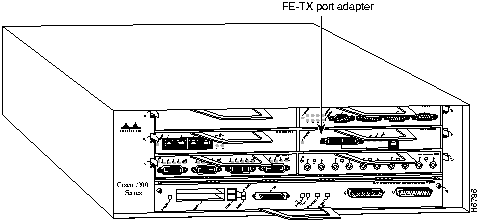
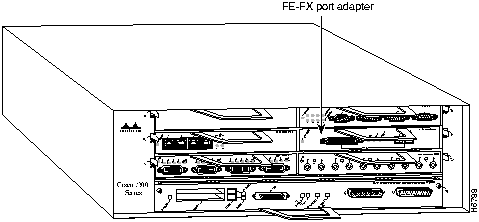
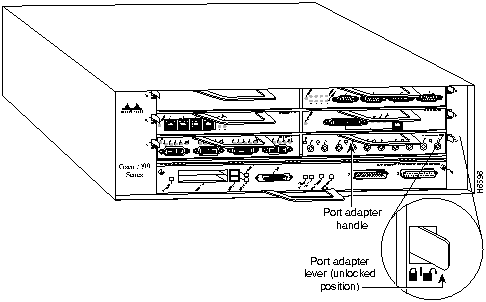
![]()

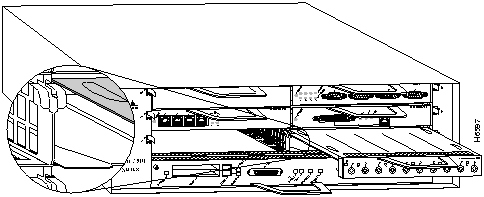
![]()
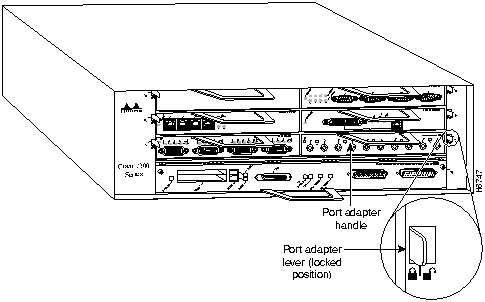
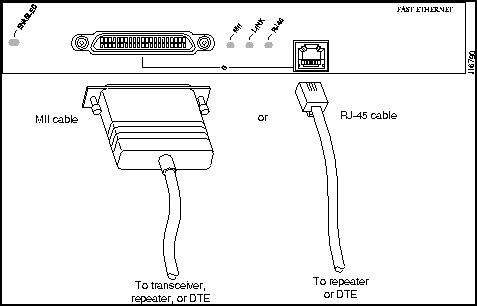

![]()

![]()
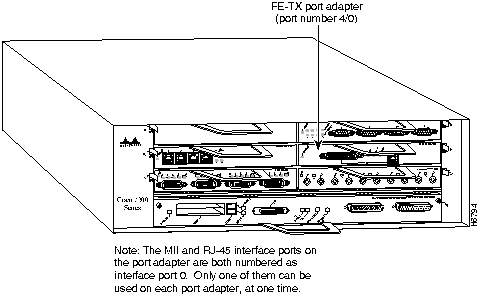
Router# disable
Router>
Router#
configure terminal
Enter configuration commands, one per line. End with CNTL/Z.
Router(config)#
Router(config)#
interface fa 4/0
Router(config-int)#
ip address 1.1.1.10 255.255.255.0
Router(config-int)#
no shutdown
Router#
copy running-config startup-config
[OK]
Router#
(slot 4, Fast Ethernet interface port 0). Descriptions are limited to fields that are relevant for establishing and verifying the configuration. After configuring the new FE interface, use show commands to display the status of the new interface or all interfaces, or to verify changes you have made.
Router# configure terminal
Enter configuration commands, one per line. End with CNTL/Z.
Router(config)#
Router(config)# interface fastethernet 4/0
Router(config-if)# full-duplex
Ctrl-z
Router# sh int fa 4/0
FastEthernet 4/0 is administratively up, line protocol is up
(display text omitted)
Encapsulation ARPA, loopback not set, keepalive not set, fdx, 100BaseTX
Router# config t
Enter configuration commands, one per line. End with CNTL/Z.
Router(config)# int fa 4/0
Router(config-if)# no full-duplex
Ctrl-z
Router#
Router# sh int fa 4/0
FastEthernet2/0 is administratively up, line protocol is up
(display text omitted)
Encapsulation ARPA, loopback not set, keepalive not set, hdx, 100BaseTX
(display text omitted)
Router# config t
Enter configuration commands, one per line. End with CNTL/Z.
Router(config)# int fa 4/0
Router(config-if)# media-type mii
Ctrl-z
Router# sh int fa 4/0
FastEthernet3/0/0 is administratively up, line protocol is up
(display text omitted)
Encapsulation ARPA, loopback not set, keepalive not set, hdx, MII
(display text omitted)
Router# sh int fa 4/0
FastEthernet4/0 is administratively down, line protocol is down
Hardware is DEC21140, address is 1.1.1.11 (bia 0000)
MTU 1500 bytes, BW 100000 Kbit, DLY 100 usec, rely 255/255, load 1/255
Encapsulation ARPA, loopback not set, keepalive not set, fdx, 100BaseTX
(display text omitted)
Router# show interfaces fastethernet 2/0
FastEthernet4/0 is administratively down, line protocol is down
Hardware is DEC21140, address is 1.1.1.11 (bia 0000)
MTU 1500 bytes, BW 100000 Kbit, DLY 100 usec, rely 255/255, load 1/255
Encapsulation ARPA, loopback not set, keepalive not set, fdx, 100BaseTX
ARP type: ARPA, ARP Timeout 4:00:00
Last input 3:08:43, output 3:08:42, output hang never
Last clearing of "show interface" counters 2:58:36
Output queue 0/40, 0 drops; input queue 0/75, 0 drops
5 minute input rate 0 bits/sec, 0 packets/sec
5 minute output rate 0 bits/sec, 0 packets/sec
0 packets input, 0 bytes, 0 no buffer
Received 0 broadcasts, 0 runts, 0 giants
0 input errors, 0 CRC, 0 frame, 0 overrun, 0 ignored, 0 abort
0 watchdog, 0 multicast
0 input packets with dribble condition detected
0 packets output, 0 bytes, 0 underruns
0 output errors, 0 collisions, 0 interface resets, 0 restarts
0 babbles, 0 late collision, 0 deferred
0 lost carrier, 0 no carrier
0 output buffer failures, 0 output buffers swapped out
Router# show version
Cisco Internetwork Operating System Software
IOS (tm) 7200 Software (C7200-J-M), Version 11.1(472) [biff 105]
Copyright (c) 1986-1996 by cisco Systems, Inc.
Compiled Sun 21-Apr-95 12:22 by
Image text-base: 0x600088A0, data-base: 0x605A4000
ROM: System Bootstrap, Version 11.1 (10979)RELEASED SOFTWARE
Router uptime is 4 hours, 22 minutes
System restarted by reload
System image file is "slot0:c7200-j-mz.960421", booted via slot0
cisco 7200 (R4700) processor with 22528K/10240K bytes of memory.
R4700 processor, Implementation 33, Revision 1.0 (Level 2 Cache)
Last reset from power-on
Bridging software.
X.25 software, Version 2.0, NET2, BFE and GOSIP compliant.
Chassis Interface.
4 Ethernet/IEEE 802.3 interfaces.
2 FastEthernet/IEEE 802.3 interfaces.
125K bytes of non-volatile configuration memory.
20480K bytes of Flash PCMCIA card at slot 0 (Sector size 128K).
8192K bytes of Flash internal SIMM (Sector size 256K).
Configuration register is 0x2
Router# show diag 2
Slot 2:
Fast-ethernet port adapter, 1 port
Port adapter is analyzed
Port adapter insertion time 2d09h ago
Hardware revision 255.255 Board revision A0
Serial number 4294967295 Part number 73-1556-04
Test history 0x0 RMA number 00-00-00
EEPROM format version 1
EEPROM contents (hex):
0x20: 01 02 01 01 FF FF FF FF 49 06 14 04 00 00 00 00
0x30: 50 00 00 00 FF FF FF FF FF FF FF FF FF FF FF FF
Router# ping 1.1.1.10 <Return>
Type escape sequence to abort.
Sending 5, 100-byte ICMP Echoes to 1.1.1.10, timeout is 2 seconds:
!!!!!
Success rate is 100 percent (5/5), round-trip min/avg/max = 1/15/64 ms
Router#
If the connection fails, verify that you have the correct IP address for the server and that the server is active
(powered on), and repeat the ping command.
![]()
http://www.cisco.com.
cco.cisco.com.
ccohelp@cisco.com.
For additional information, contact
ccoteam@cisco.com.
tac@cisco.com.
To obtain general information about Cisco Systems, Cisco products, or upgrades, contact 800 553-6387, 408 526-7208, or
csrep@cisco.com.

![]()
![]()
![]()
![]()
![]()
![]()
![]()
![]()